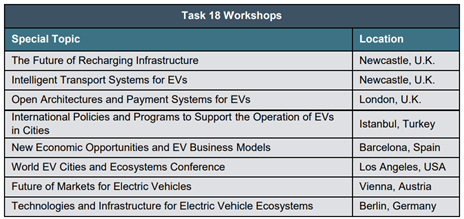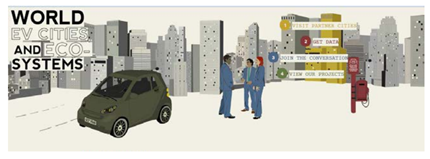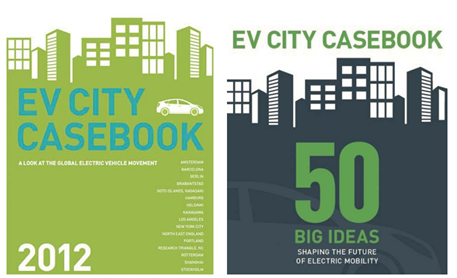Task 18
EV Ecosystems
Objective of Task
The overarching goal of this Task was to advance international policy and the design of EV ecosystems. This included the following processes:
- Foresight workshops in leading cities are assembling experts from municipalities, regional authorities, governments, and industry to explore specific areas of opportunity,
- A future outlook to showcase pioneering projects around the world and establish an expert view of the emerging challenges and opportunities in EV markets, technologies, and services,
- A Web portal of EV cities and ecosystems, developed at the University of California, Davis, will provide a database of pioneering EV programs and connect international experts to facilitate policy exchange and problem solving,
- Conferences of pioneering EV cities and regions will convene and bring individuals together who are shaping the future development and design of EV ecosystems.
working method
Foresight Workshops
The main data collection activity is a series of one-day foresight workshops. In each workshop, 10 to 20 experts will assemble to share insights, ambitions, and visions that will be promoted in a summary report to an international audience of policy makers and industrialists. Each workshop will investigate a different priority area, such as business models, social change, fleets, and smart grids.
Web Portal
Sharing information to advance urban transport systems by using a Web portal designed for this purpose is the best method for instant worldwide delivery of information.
Alliances with Global EV City Projects and Initiatives
Over the last 36 months, Task 18 has developed partnerships with a number of international EV projects focused on cities and regions. These collaborative working relationships are facilitating the sharing of data and resources, thereby connecting Task 18 participants to a more extensive global network. Collaborative partners include the Clean Energy Ministerial’s Electric Vehicle Initiative, the Clinton Climate Change Foundation’s C40 Cities Program, the Rocky Mountain Institute’s Project Get Ready, and the European Commission’s Green eMotion Project.
Task 18 Governance Structure
David Beeton (U.K.) and Thomas Turrentine (U.S.) are serving as the Operating Agents. Additionally, a Task 18 Steering Group approves amendments to Task activities and the budget. David Howell, at the U.S. Department of Energy’s Vehicle Technologies Office, is the Steering Committee Chair. Luís Reis, of INTELI in Portugal, is the Steering Committee Co-chair.
Results
Task 18 is in its fourth year of operation and is making great strides toward supporting the development and design of "EV Ecosystems" that foster a total environment for the mass operation of plug-in EVs.
Foresight Workshops and Conferences Six workshops on various topics have occurred to date in cities in the U.K., Istanbul, Barcelona, Los Angeles, Vienna, and Berlin.
Table 1: Completed Task 18 Workshops

World EV Cities and Ecosystems Web Portal and EV City Casebook
Task 18 involves active collaborations with other international projects. The Global Electric Vehicle Insight Exchange (EVX) World EV Cities and Ecosystems Web portal (www.worldevcities.org) was launched in May 2012 at the first EV Cities and Ecosystems Conference, which is a partnership among IA-HEV Task 18, Electric Vehicles Initiative, Rocky Mountain Institute, IEA, Clinton Climate Change Initiative, and the University of California, Davis (UCLA). The Web portal continues to add new cities and regions. Table 2 lists the cities currently on www.worldevcities.org.

Figure 1 The Website www.worldevcities.org shows the latest localities added
Along with the Web portal, the EV City Casebook (Figure 2) was published in 2012, which presents informative case studies on city and regional EV deployment efforts around the world. These case studies are illustrative examples of how pioneering cities are preparing the ground for mass market EV deployment. They offer both qualitative and quantitative information on cities’ EV goals, progress, policies, incentives, and lessons learned to date.
Table 2 List of World EV Cities at www.worldcities.org

The purpose of the EV City Casebook is to share experiences on EV demonstration and deployment, identify challenges and opportunities, and highlight best practices for creating thriving EV ecosystems. These studies seek to enhance understanding of the most effective policy measures to foster the uptake of EVs in urban areas.
EV City Casebook: 50 Big Ideas Shaping the Future of Electric Mobility
2014 saw the publication of a new EV City Casebook which highlighted examples of transformative policies, technologies, projects and business models. 50 Big Ideas were selected from an open call for nominations in February 2014, with the final casebook presented to the IA-HEV Executive Committee in Vancouver in Autumn 2014.

Figure 2 EV City Casebook available at www.ieahev.org and the "50 Big Ideas" Casebook which can be downloaded at www.urbanforesight.org/casebook.html
Objective of Task
The overarching goal of this Task was to advance international policy and the design of EV ecosystems. This included the following processes:
- Foresight workshops in leading cities are assembling experts from municipalities, regional authorities, governments, and industry to explore specific areas of opportunity,
- A future outlook to showcase pioneering projects around the world and establish an expert view of the emerging challenges and opportunities in EV markets, technologies, and services,
- A Web portal of EV cities and ecosystems, developed at the University of California, Davis, will provide a database of pioneering EV programs and connect international experts to facilitate policy exchange and problem solving,
- Conferences of pioneering EV cities and regions will convene and bring individuals together who are shaping the future development and design of EV ecosystems.
working method
Foresight Workshops
The main data collection activity is a series of one-day foresight workshops. In each workshop, 10 to 20 experts will assemble to share insights, ambitions, and visions that will be promoted in a summary report to an international audience of policy makers and industrialists. Each workshop will investigate a different priority area, such as business models, social change, fleets, and smart grids.
Web Portal
Sharing information to advance urban transport systems by using a Web portal designed for this purpose is the best method for instant worldwide delivery of information.
Alliances with Global EV City Projects and Initiatives
Over the last 36 months, Task 18 has developed partnerships with a number of international EV projects focused on cities and regions. These collaborative working relationships are facilitating the sharing of data and resources, thereby connecting Task 18 participants to a more extensive global network. Collaborative partners include the Clean Energy Ministerial’s Electric Vehicle Initiative, the Clinton Climate Change Foundation’s C40 Cities Program, the Rocky Mountain Institute’s Project Get Ready, and the European Commission’s Green eMotion Project.
Task 18 Governance Structure
David Beeton (U.K.) and Thomas Turrentine (U.S.) are serving as the Operating Agents. Additionally, a Task 18 Steering Group approves amendments to Task activities and the budget. David Howell, at the U.S. Department of Energy’s Vehicle Technologies Office, is the Steering Committee Chair. Luís Reis, of INTELI in Portugal, is the Steering Committee Co-chair.
Results
Task 18 is in its fourth year of operation and is making great strides toward supporting the development and design of "EV Ecosystems" that foster a total environment for the mass operation of plug-in EVs.
Foresight Workshops and Conferences Six workshops on various topics have occurred to date in cities in the U.K., Istanbul, Barcelona, Los Angeles, Vienna, and Berlin.
Table 1: Completed Task 18 Workshops

World EV Cities and Ecosystems Web Portal and EV City Casebook
Task 18 involves active collaborations with other international projects. The Global Electric Vehicle Insight Exchange (EVX) World EV Cities and Ecosystems Web portal (www.worldevcities.org) was launched in May 2012 at the first EV Cities and Ecosystems Conference, which is a partnership among IA-HEV Task 18, Electric Vehicles Initiative, Rocky Mountain Institute, IEA, Clinton Climate Change Initiative, and the University of California, Davis (UCLA). The Web portal continues to add new cities and regions. Table 2 lists the cities currently on www.worldevcities.org.

Figure 1 The Website www.worldevcities.org shows the latest localities added
Along with the Web portal, the EV City Casebook (Figure 2) was published in 2012, which presents informative case studies on city and regional EV deployment efforts around the world. These case studies are illustrative examples of how pioneering cities are preparing the ground for mass market EV deployment. They offer both qualitative and quantitative information on cities’ EV goals, progress, policies, incentives, and lessons learned to date.
Table 2 List of World EV Cities at www.worldcities.org

The purpose of the EV City Casebook is to share experiences on EV demonstration and deployment, identify challenges and opportunities, and highlight best practices for creating thriving EV ecosystems. These studies seek to enhance understanding of the most effective policy measures to foster the uptake of EVs in urban areas.
EV City Casebook: 50 Big Ideas Shaping the Future of Electric Mobility
2014 saw the publication of a new EV City Casebook which highlighted examples of transformative policies, technologies, projects and business models. 50 Big Ideas were selected from an open call for nominations in February 2014, with the final casebook presented to the IA-HEV Executive Committee in Vancouver in Autumn 2014.

 Back to Tasks
Back to Tasks